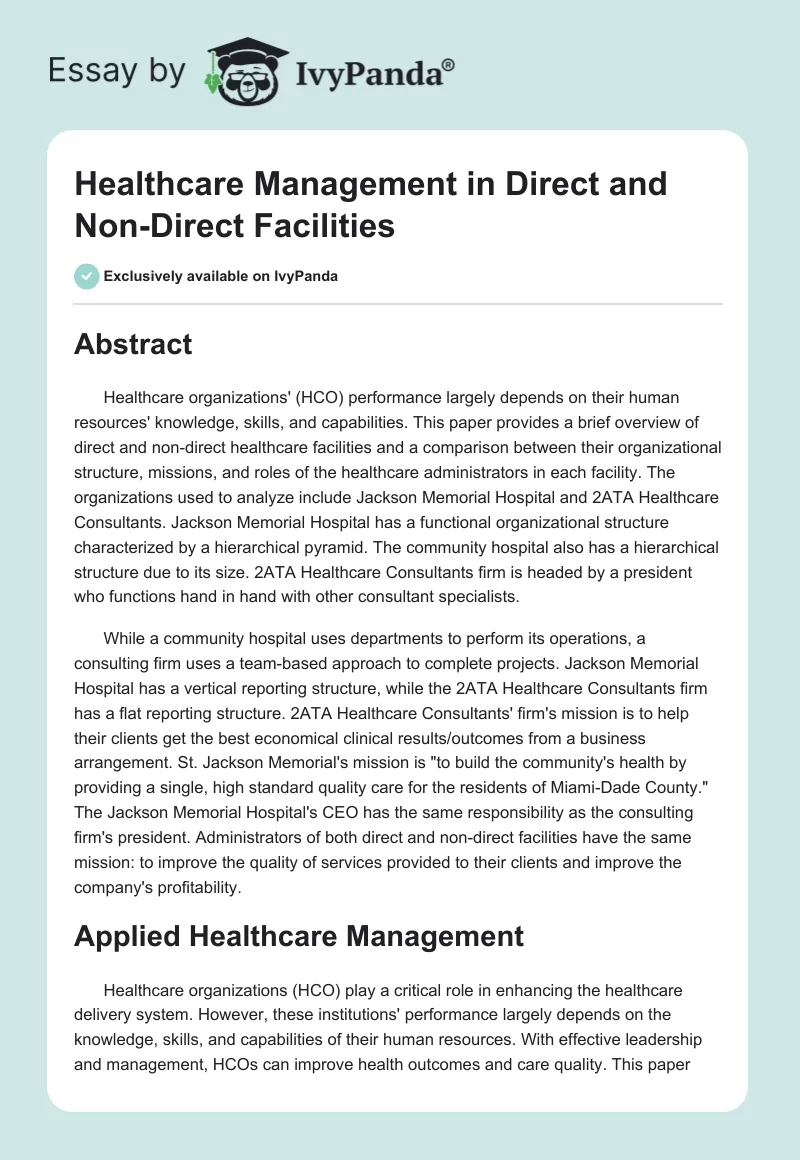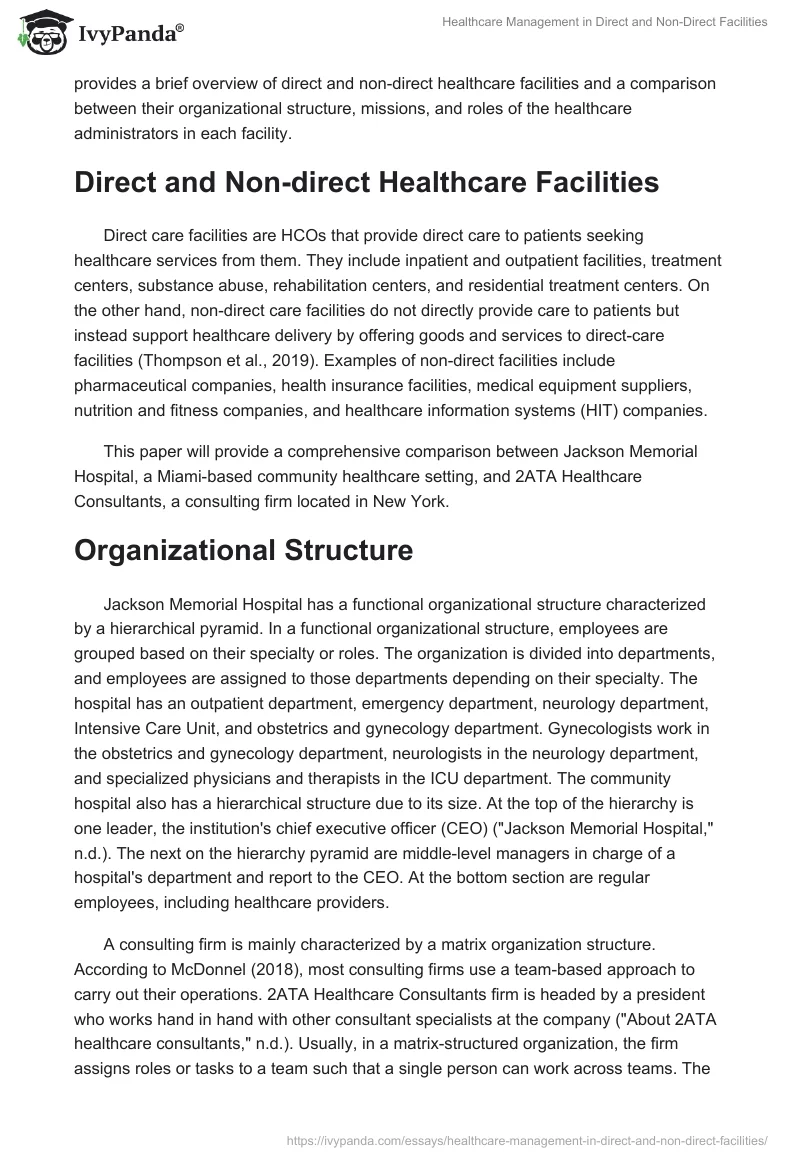Abstract
Healthcare organizations’ (HCO) performance largely depends on their human resources’ knowledge, skills, and capabilities. This paper provides a brief overview of direct and non-direct healthcare facilities and a comparison between their organizational structure, missions, and roles of the healthcare administrators in each facility. The organizations used to analyze include Jackson Memorial Hospital and 2ATA Healthcare Consultants. Jackson Memorial Hospital has a functional organizational structure characterized by a hierarchical pyramid. The community hospital also has a hierarchical structure due to its size. 2ATA Healthcare Consultants firm is headed by a president who functions hand in hand with other consultant specialists.
While a community hospital uses departments to perform its operations, a consulting firm uses a team-based approach to complete projects. Jackson Memorial Hospital has a vertical reporting structure, while the 2ATA Healthcare Consultants firm has a flat reporting structure. 2ATA Healthcare Consultants’ firm’s mission is to help their clients get the best economical clinical results/outcomes from a business arrangement. St. Jackson Memorial’s mission is “to build the community’s health by providing a single, high standard quality care for the residents of Miami-Dade County.” The Jackson Memorial Hospital’s CEO has the same responsibility as the consulting firm’s president. Administrators of both direct and non-direct facilities have the same mission: to improve the quality of services provided to their clients and improve the company’s profitability.
Applied Healthcare Management
Healthcare organizations (HCO) play a critical role in enhancing the healthcare delivery system. However, these institutions’ performance largely depends on the knowledge, skills, and capabilities of their human resources. With effective leadership and management, HCOs can improve health outcomes and care quality. This paper provides a brief overview of direct and non-direct healthcare facilities and a comparison between their organizational structure, missions, and roles of the healthcare administrators in each facility.
Direct and Non-direct Healthcare Facilities
Direct care facilities are HCOs that provide direct care to patients seeking healthcare services from them. They include inpatient and outpatient facilities, treatment centers, substance abuse, rehabilitation centers, and residential treatment centers. On the other hand, non-direct care facilities do not directly provide care to patients but instead support healthcare delivery by offering goods and services to direct-care facilities (Thompson et al., 2019). Examples of non-direct facilities include pharmaceutical companies, health insurance facilities, medical equipment suppliers, nutrition and fitness companies, and healthcare information systems (HIT) companies.
This paper will provide a comprehensive comparison between Jackson Memorial Hospital, a Miami-based community healthcare setting, and 2ATA Healthcare Consultants, a consulting firm located in New York.
Organizational Structure
Jackson Memorial Hospital has a functional organizational structure characterized by a hierarchical pyramid. In a functional organizational structure, employees are grouped based on their specialty or roles. The organization is divided into departments, and employees are assigned to those departments depending on their specialty. The hospital has an outpatient department, emergency department, neurology department, Intensive Care Unit, and obstetrics and gynecology department. Gynecologists work in the obstetrics and gynecology department, neurologists in the neurology department, and specialized physicians and therapists in the ICU department. The community hospital also has a hierarchical structure due to its size. At the top of the hierarchy is one leader, the institution’s chief executive officer (CEO) (“Jackson Memorial Hospital,” n.d.). The next on the hierarchy pyramid are middle-level managers in charge of a hospital’s department and report to the CEO. At the bottom section are regular employees, including healthcare providers.
A consulting firm is mainly characterized by a matrix organization structure. According to McDonnel (2018), most consulting firms use a team-based approach to carry out their operations. 2ATA Healthcare Consultants firm is headed by a president who works hand in hand with other consultant specialists at the company (“About 2ATA healthcare consultants,” n.d.). Usually, in a matrix-structured organization, the firm assigns roles or tasks to a team such that a single person can work across teams. The firm’s team comprises a nurse practitioner, ankle specialist, clinical professor, and safety officer. These members, despite having different specialties, collectively work on the project’s deliverables. Therefore, the firm’s president can be in charge of a project where members from different departments collaborate to deliver a service to a customer.
While a community hospital uses departments to perform its operations, a consulting firm uses a team-based approach to complete projects. Jackson Memorial Hospital has a vertical reporting structure, while the 2ATA Healthcare Consultants firm has a flat reporting structure. In vertical structures, the CEO delegates power to middle-level employers who, in turn, govern the general employees. In a flat reporting structure, one person is in charge of the organization, but there is minimal middle management between the general employees and the CEO.
The main similarity between the direct and non-direct HCO is that one person leads the organization. The main difference is that direct HCO are centralized and have a vertical organizational structure, while non-direct HCO are flat. In a direct HCO, authority exists at the higher, middle, and lower levels. In contrast, in non-direct HCO, authority is delegated from the top-most level to the bottom-level employees. The direct HCO is divided into departments, and individuals are assigned to the departments based on their skills and specialties (functional structure). A non-direct HCO is team-based – projects are assigned to teams, and an individual can work across teams.
Healthcare administrators’ Mission and Roles in Each Facility
2ATA Healthcare Consultants’ firm’s mission is to help their clients get the best economical clinical results/outcomes from a business arrangement. The firm develops wound care programs for hospitals and organizes partnerships between hospitals (“About 2ATA healthcare consultants,” n.d.). St. Jackson Memorial’s mission is “to build the community’s health by providing a single, high standard of quality care for the residents of Miami-Dade County” (“Jackson Memorial Hospital,” n.d.). The consulting firm’s president conducts long-term strategic planning, develops and enforces policies and procedures, and reviews budgets and financial reports to plan strategies for increasing its profitability.
The Jackson Memorial Hospital’s CEO has the same responsibility as the consulting firm’s president. According to his profile, the hospital CEO helped the hospital change its financial losses within one year of his leadership. He reversed an $82 million loss and even made a surplus of $8 million in the first fiscal year of his tenure (“Jackson Memorial Hospital,” n.d.). Concurrently, Jackson Memorial’s CEO helped improve healthcare quality at the hospital, including patient satisfaction scores (“Jackson Memorial Hospital,” n.d.). From his achievements, it is clear that the hospital’s CEO implemented strategic decisions that improved the hospital’s outcomes. Although Jackson Memorial Hospital operates independently, it has several healthcare systems that operate under its umbrella. The hospital’s CEO oversees all hospital services and programs of the hospital and its affiliates.
Administrators of both direct and non-direct facilities have the same mission: to improve the quality of services provided to their clients and improve the company’s profitability. According to Thompson et al. (2019), HCO managers have six primary functions: planning, organizing, staffing, controlling, directing, and decision-making. Planning involves setting direction for the firm, while organization involves designing the organization’s reporting structures, power distribution, interaction patterns, and teamwork assignments. Staffing and controlling include recruiting and retaining best-performing employees and monitoring organizational performance, respectively. Lastly, directing involves establishing good leadership practices, including setting standards of behavior. Managers of both direct and non-direct
From a personal perspective, non-direct HCO are business-oriented, while direct HCO is patient-oriented. Although both facilities aim to improve their services to serve their customers best, direct HCO has a different approach. The healthcare industry is a safety-sensitive industry and operates under various stringent regulations that shape and influence its cultural practices. Currently, direct HCOs aim for the six IOM-endorsed quality metrics to improve their service quality (Agency for Healthcare Research and Quality, 2018). The six-quality metrics in direct HCO include safety, effectiveness, timeliness, equity, patient-centeredness, and efficiency. Therefore, it can be surmised that providing quality services is a legal/regulatory mandate for a direct HCO. Arguably, providing quality services is a business strategy to increase the company’s profitability and growth. However, for a direct HCO, providing quality services is required to improve patient safety.
Conclusion
Non-direct and direct facilities have different organizational structures due to size differences and the facility’s operations nature. A large hospital (direct facility) can have a functional organizational structure with vertical/hierarchical reporting structures. In contrast, a small consulting firm (non-direct facility) has a matrix model with a flat organizational structure. Both facilities have the same mission: to improve the quality of services and the organization’s profitability. However, the management approach to these goals is different: one is a business strategy to enhance profitability and growth, while the other is a mandate to improve patient safety.
References
About 2ATA healthcare consultants. (n.d.). 2ATA Healthcare Consultants. Web.
Agency for Healthcare Research and Quality. (2018). Six domains of health care quality. Agency for Healthcare Research and Quality. Web.
Jackson memorial hospital. (n.d.). Jackson Health System. Web.
McDonnel, S. (2018). Consulting firm organizational structure. AZCentral. Web.
Thompson, J., Buchbinder, S. B., Shanks, N. H., & Kite, B. (2019). An overview of healthcare management. In Buchbinder, S. B., & Shanks, N. H. (Eds.), Introduction to healthcare management (pp. 1–19). Jones & Bartlett Learning.


